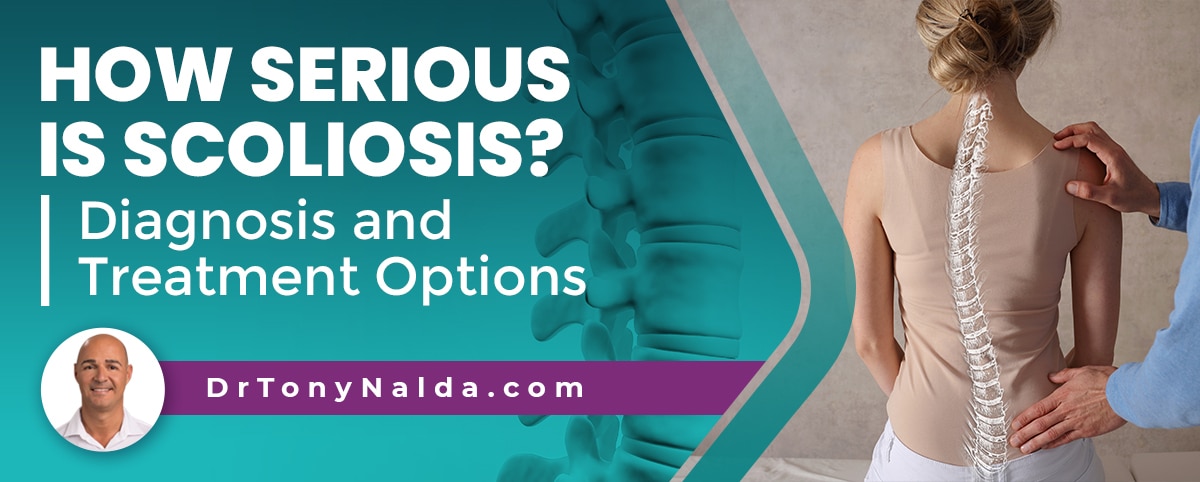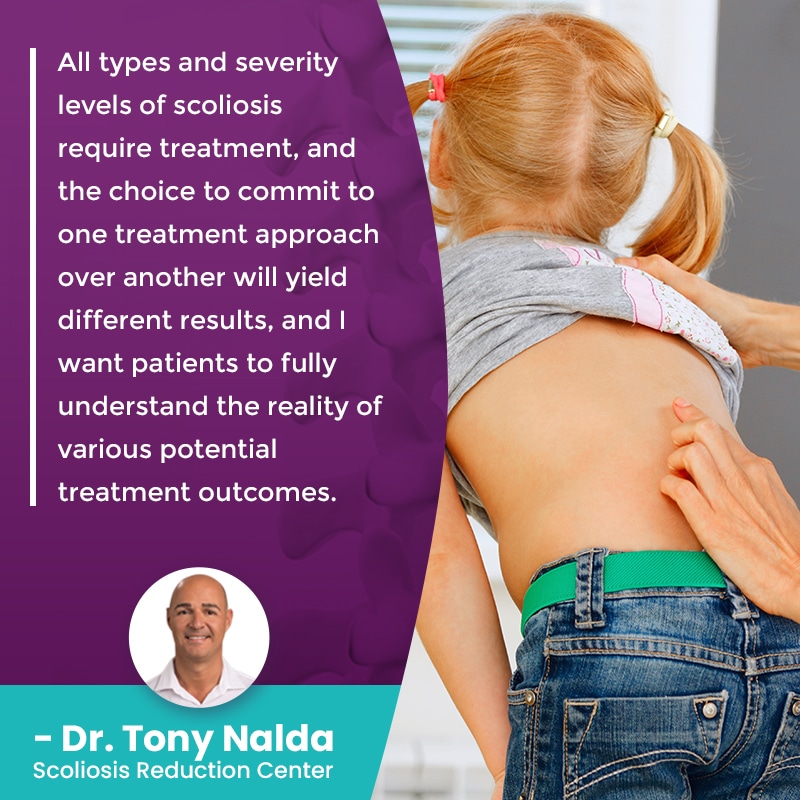How Serious Is Scoliosis? Diagnosis and Treatment Options

When scoliosis is first diagnosed, patients have an important decision to make: how to treat the condition moving forward. Deciding how to treat scoliosis can have life-long consequences as it can shape the long-term health and function of the spine; different types of scoliosis treatment affect the spine differently.
Scoliosis can vary widely in severity from mild to moderate and severe to very severe, but all cases of scoliosis should be taken seriously because as a progressive condition, where a patient's scoliosis is at the time of diagnosis isn't indicative of where it will stay.
Diagnosing scoliosis involves meeting a number of parameters that set the condition apart from other spinal conditions that cause a loss of its healthy curves.
Table of Contents
How is Scoliosis Diagnosed?
Diagnosing scoliosis isn't always easy; in fact, it's a common scenario for adults that the time of diagnosis is when they find out they've been living with the condition since adolescence.
Scoliosis is diagnosed through a combined physical examination that commonly includes an Adam's forward bend test, taking the patient's family history and medical history, and X-ray results.
Scoliosis involves the development of an unnatural sideways-bending and rotating spinal curvature, and in addition, the size of a scoliotic curve has to meet a minimum size requirement: Cobb angle of at least 10 degrees.
A patient's Cobb angle is determined during X-ray by drawing lines from the tops and bottoms of the curve's most-tilted vertebrae, at its apex, and the intersecting angle is expressed in degrees.
The higher a patient's Cobb angle measurement, the more severe a condition, and the more likely it is that its effects will be overt:
- Mild scoliosis: Cobb angle measurement of between 10 and 25 degrees
- Moderate scoliosis: Cobb angle measurement of between 25 and 40 degrees
- Severe scoliosis: Cobb angle measurement of 40+ degrees
- Very-severe scoliosis: Cobb angle measurement of 80+ degrees
So these are the severity levels of scoliosis, but they don't indicate how serious scoliosis can get, only how severe a condition is at the time of diagnosis.
Scoliosis is a Progressive Condition
As mentioned, scoliosis is a progressive condition, meaning its very nature is to get worse over time, and this means that even scoliosis diagnosed as mild can easily progress to become moderate, severe, or very severe.
In fact, here at the Scoliosis Reduction Center, the majority of my patients are diagnosed with moderate scoliosis because the signs of mild scoliosis can be too subtle to notice, and it's not until conditions progress to the next level that symptoms of scoliosis become more overt.
Scoliosis progressing means the size of the unnatural spinal curve is increasing, as are the condition's uneven forces, and their effects.
Scoliosis progressing also means the condition is getting more complex to treat; the spine gets more rigid as it progresses and less responsive to treatment and the condition's effects become more established and difficult to reverse.
While we don't always know what triggers the initial onset of scoliosis, we do understand what triggers its progression: growth and development.
Because their spines are still growing, children are the most at risk for continued and rapid progression because of their growth spurts.
So as progression makes condition effects more noticeable, what are the typical signs of scoliosis?
What are the Signs of Scoliosis?
 While there are never guarantees when treating scoliosis, conditions that are diagnosed and treated early in the progressive line tend to respond better.
While there are never guarantees when treating scoliosis, conditions that are diagnosed and treated early in the progressive line tend to respond better.
Smaller curves are less complex to treat, and it's far more effective to proactively work towards preventing progression and increasing condition effects, than it is to work towards reversing them once they're established.
In adult scoliosis, the main condition effect that brings them in for a diagnosis and treatment is pain: back pain and pain that radiates into the extremities due to nerve compression.
The signs of childhood scoliosis are more subtle, and this is because the main symptom is postural deviation, and as scoliosis doesn't become a compressive condition until skeletal maturity has been reached, it's not commonly painful for children; it's compression of the spine and its surrounding muscles and nerves that causes the majority of condition-related pain.
As a child grows, however, those postural changes can become more overt and lead to a diagnosis.
Common postural changes in children can include:
- Uneven shoulders
- Uneven shoulder blades
- The development of a rib cage arch
- Uneven hips
- Arms and legs that appear to hang at different lengths
Additional signs related to the condition's disruption of the body's overall symmetry can include changes to gait, balance, and coordination.
In addition to a condition's severity level, another factor affecting how serious scoliosis is is the type in question.
Different Types of Scoliosis
There are also different types of scoliosis a person can develop, and type is determined by causation.
The most common type of scoliosis to affect both children and adults is idiopathic scoliosis, and this means the cause is unknown, and the most prevalent type of scoliosis overall is adolescent idiopathic scoliosis (AIS) diagnosed between the ages of 10 and 18.
Approximately 80 percent of known diagnosed scoliosis cases are classified as idiopathic scoliosis, and the remaining 20 percent are associated with known causes: neuromuscular scoliosis, degenerative scoliosis, and congenital scoliosis.
Neuromuscular scoliosis is caused by the presence of a larger neuromuscular condition like spina bifida, cerebral palsy, and muscular dystrophy; these cases are serious because they are atypical and the underlying neuromuscular condition has to be the focus of treatment, complicating the process.
Degenerative scoliosis is common in older adults and is caused by natural age-related spinal degeneration and the cumulative effect of certain lifestyle choices.
Congenital scoliosis is caused by a malformed spine that occurs as its developing in utero, so babies are born with the condition, and again, as an atypical type, it can be difficult to treat, and as cases of congenital scoliosis often present with additional congenital abnormalities, they are always serious.
So now that we've covered scoliosis severity, progression, and the different types, let's talk about treatment.
Treating Scoliosis
 All types and severity levels of scoliosis require treatment, and the choice to commit to one treatment approach over another will yield different results, and I want patients to fully understand the reality of potential treatment outcomes.
All types and severity levels of scoliosis require treatment, and the choice to commit to one treatment approach over another will yield different results, and I want patients to fully understand the reality of potential treatment outcomes.
For example, traditional scoliosis treatment offers a surgical treatment response, and while spinal fusion surgery can help straighten a bent spine, the way it does so is contrary to the spine's movement-based design so can cost the spine in terms of its overall health, strength, and function.
Modern conservative scoliosis treatment, however, offers a non operative treatment alternative that works towards preserving as much of the spine's natural strength and function as possible, and this is because results can be achieved through a less-invasive approach, and the reality is that many scoliosis patients don't require surgery.
Here at the Center, conservative treatment is proactive; it works towards preventing progression, increasing condition effects, and the need for invasive spinal surgery in the future.
Through a combination of condition-specific chiropractic care, physical therapy, corrective bracing, and rehabilitation, conditions can be impacted on every level.
As a structural spinal condition, it has to be impacted on a structural level first and foremost, and this is worked towards through a series of chiropractic techniques and manual adjustments that work towards realigning the spine and reducing the size of the unnatural curvature of the spine.
Once I start to see structural results, I can shift the focus to increasing core strength because this means the spine's surrounding muscles are stronger and better able to support and stabilize the spine.
Corrective bracing is known as particularly effective on growing spines so is a common facet of treatment for adolescent idiopathic scoliosis.
Rehabilitation involves a series of custom-prescribed home exercises to further stabilize and heal the spine from home.
When scoliosis is treated proactively and conservatively, many cases of scoliosis can be improved.
Conclusion
Scoliosis patients need to understand that while a diagnosis of scoliosis doesn't mean a life of limitations, it does have to be taken seriously because when it is, scoliosis can be highly treatable.
If a diagnosis is responded to with a proactive conservative treatment approach, and particularly with early detection, there are fewer limits to what can be achieved.
Scoliosis affects all ages, and different types of scoliosis can be considered more serious solely because they are atypical and feature atypical curvature types and patterns; cases that are often considered the most serious are patients diagnosed with neuromuscular scoliosis.
When a larger underlying medical condition/disease caused the development of scoliosis, the larger issue has to be the focus of treatment, complicating the process.
Spinal imbalance and instability will get worse if conditions are left untreated, and the longer scoliosis isn't taken seriously, the more challenging it will be to attempt to reverse the its effects.
Dr. Tony Nalda
DOCTOR OF CHIROPRACTIC
After receiving an undergraduate degree in psychology and his Doctorate of Chiropractic from Life University, Dr. Nalda settled in Celebration, Florida and proceeded to build one of Central Florida’s most successful chiropractic clinics.
His experience with patients suffering from scoliosis, and the confusion and frustration they faced, led him to seek a specialty in scoliosis care. In 2006 he completed his Intensive Care Certification from CLEAR Institute, a leading scoliosis educational and certification center.
About Dr. Tony Nalda
 Ready to explore scoliosis treatment? Contact Us Now
Ready to explore scoliosis treatment? Contact Us Now





